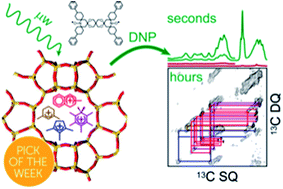当前位置:
X-MOL 学术
›
Chem. Sci.
›
论文详情
Our official English website, www.x-mol.net, welcomes your
feedback! (Note: you will need to create a separate account there.)
Fast detection and structural identification of carbocations on zeolites by dynamic nuclear polarization enhanced solid-state NMR†
Chemical Science ( IF 7.6 ) Pub Date : 2018-10-02 00:00:00 , DOI: 10.1039/c8sc03848a Dong Xiao 1, 2, 3 , Shutao Xu 4 , Nick J Brownbill 3 , Subhradip Paul 5 , Li-Hua Chen 6 , Shane Pawsey 7 , Fabien Aussenac 8 , Bao-Lian Su 6, 9 , Xiuwen Han 1 , Xinhe Bao 1 , Zhongmin Liu 1, 4 , Frédéric Blanc 3, 10
Chemical Science ( IF 7.6 ) Pub Date : 2018-10-02 00:00:00 , DOI: 10.1039/c8sc03848a Dong Xiao 1, 2, 3 , Shutao Xu 4 , Nick J Brownbill 3 , Subhradip Paul 5 , Li-Hua Chen 6 , Shane Pawsey 7 , Fabien Aussenac 8 , Bao-Lian Su 6, 9 , Xiuwen Han 1 , Xinhe Bao 1 , Zhongmin Liu 1, 4 , Frédéric Blanc 3, 10
Affiliation

|
Acidic zeolites are porous aluminosilicates used in a wide range of industrial processes such as adsorption and catalysis. The formation of carbocation intermediates plays a key role in reactivity, selectivity and deactivation in heterogeneous catalytic processes. However, the observation and determination of carbocations remain a significant challenge in heterogeneous catalysis due to the lack of selective techniques of sufficient sensitivity to detect their low concentrations. Here, we combine 13C isotopic enrichment and efficient dynamic nuclear polarization magic angle spinning nuclear magnetic resonance spectroscopy to detect carbocations in zeolites. We use two dimensional 13C–13C through-bond correlations to establish their structures and 29Si–13C through-space experiments to quantitatively probe the interaction between multiple surface sites of the zeolites and the confined hydrocarbon pool species. We show that a range of various membered ring carbocations are intermediates in the methanol to hydrocarbons reaction catalysed by different microstructural β-zeolites and highlight that different reaction routes for the formation of both targeted hydrocarbon products and coke exist. These species have strong van der Waals interaction with the zeolite framework demonstrating that their accumulation in the channels of the zeolites leads to deactivation. These results enable understanding of deactivation pathways and open up opportunities for the design of catalysts with improved performances.
中文翻译:

通过动态核极化增强固态 NMR 快速检测和结构鉴定沸石上的碳阳离子†
酸性沸石是多孔硅铝酸盐,广泛用于吸附和催化等工业过程。碳正离子中间体的形成在多相催化过程的反应性、选择性和失活中起着关键作用。然而,由于缺乏足够灵敏度的选择性技术来检测碳阳离子的低浓度,碳阳离子的观察和测定仍然是多相催化中的重大挑战。在这里,我们结合13 C 同位素富集和高效动态核极化魔角旋转核磁共振波谱来检测沸石中的碳正离子。我们使用二维13 C- 13 C 直通键关联来建立它们的结构,并使用29 Si- 13 C 直通空间实验来定量探测沸石的多个表面位点与受限烃池物种之间的相互作用。我们表明,一系列不同的元环碳阳离子是不同微观结构β-沸石催化的甲醇到烃类反应的中间体,并强调存在形成目标烃类产物和焦炭的不同反应路线。这些物质与沸石骨架具有强烈的范德华相互作用,表明它们在沸石通道中的积累导致失活。这些结果有助于了解失活途径,并为设计具有改进性能的催化剂提供了机会。
更新日期:2018-10-02
中文翻译:

通过动态核极化增强固态 NMR 快速检测和结构鉴定沸石上的碳阳离子†
酸性沸石是多孔硅铝酸盐,广泛用于吸附和催化等工业过程。碳正离子中间体的形成在多相催化过程的反应性、选择性和失活中起着关键作用。然而,由于缺乏足够灵敏度的选择性技术来检测碳阳离子的低浓度,碳阳离子的观察和测定仍然是多相催化中的重大挑战。在这里,我们结合13 C 同位素富集和高效动态核极化魔角旋转核磁共振波谱来检测沸石中的碳正离子。我们使用二维13 C- 13 C 直通键关联来建立它们的结构,并使用29 Si- 13 C 直通空间实验来定量探测沸石的多个表面位点与受限烃池物种之间的相互作用。我们表明,一系列不同的元环碳阳离子是不同微观结构β-沸石催化的甲醇到烃类反应的中间体,并强调存在形成目标烃类产物和焦炭的不同反应路线。这些物质与沸石骨架具有强烈的范德华相互作用,表明它们在沸石通道中的积累导致失活。这些结果有助于了解失活途径,并为设计具有改进性能的催化剂提供了机会。











































 京公网安备 11010802027423号
京公网安备 11010802027423号